"We wanted full control of our rooting container and substrate," says New Hampshire young plant grower Doug Cole of D.S. Cole Growers when talking about their decision to switch from paperpots to Growcoons. About three years ago, they started to work with this propagation product, and after good first results, they decided to implement this system, in a joint effort with Modiform and Klasmann-Deilmann, in their production of young plants. And along the way, Cole and his team noticed increasingly more benefits, like easier sticking and reduced rooting time to name a few.
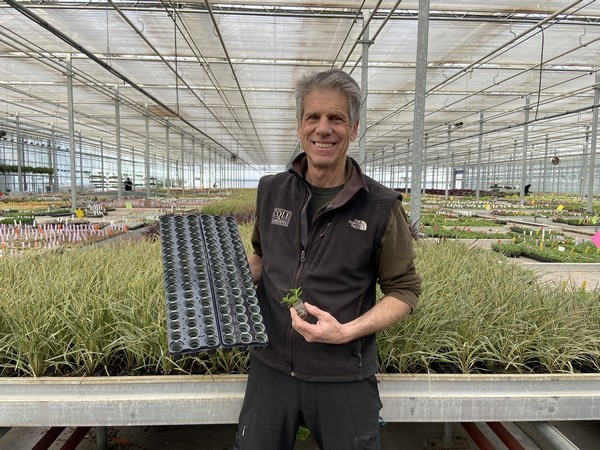
Doug Cole with the Modiform tray and Growcoon in the greenhouse.
Growcoon
Before talking about the switch from paperpots to Growcoons at D.S. Cole, let's take a closer look at the Growcoon itself. What is it, and what are the benefits? The Growcoon is a product of the German company Klasmann-Deilmann, which partnered with Maan Biobased Products in 2017, representing the Growcoons worldwide. Growcoon is a fully biodegradable net structure that will break down with microbial activity in the substrate, explains Martin van Nugteren, Sales Director at Klasmann-Deilmann Americas.
"The speed of degradation depends on environmental conditions- pH, temperature, humidity, and substrate composition. Once a Growcoon plug is transplanted, the plant roots break through the Growcoon as they grow out into the new container." And due to the net structure and fit in a tray cell, the grower has the ability to loosefill substrate in the trays. "This maintains optimal air porosity in the substrate." The net structure also provides a thin microclimate between the cell wall and substrate that promotes root development. "The healthier root zone environment promotes faster rooting, allowing for earlier grading or transplanting. And it is also reducing crop cycle times."
The Growcoon works well with automation. "There is an automatic dispenser machine for inserting the Growcoons in the plug trays. The speed and simplicity of the dispenser allow it to be installed in line with substrate filler and sticking lines or robots. The capacity of the machine can reach 50,000 cells per hour depending on tray dimension and cell count. The dispenser can be set up to run several different cell counts with minimal change over time. There is also a manual dispenser available for smaller growers that has a capacity of 3 to 4,000 cells per hour. Due to the support provided by the Growcoon, the young plants can be sorted earlier on automated grading machines as well. This is an advantage, especially for varieties that produce large leaves or spread over the cell surface by reducing damage to the leaves."
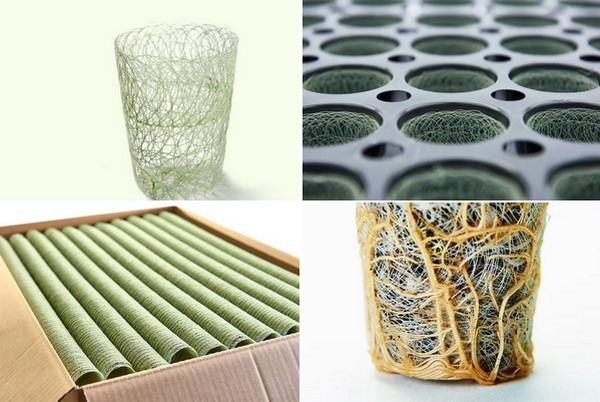
Growcoon
From paperpots to Growcoon, why?
So how was the situation at D.S. Cole, and how did the use of Growcoons change it? Up until now, Cole was purchasing paperpots to root their cuttings. "We used mostly paperpots such as Fertiss to root our cuttings. We still feel that the paperpots are good, but we wanted full control of our rooting container and substrate. As we were not making the paperpots onsite, it is hard to forecast our exact needs. We would often run short or have too many pallets in inventory for a long period. By filling our Growcoons as needed, we were able to keep a smaller inventory. In this way, the product would not dry out while in storage." But also during peak propagation weeks, the use of Growcoons makes sticking easier, adds Cole. "Usually, we were having to prefill trays and hold them, which also allowed the substrate to dry out, in turn making sticking cuttings difficult. Our sticking crew prefers to stick cuttings into Growcoon trays since the substrate is easier to stick into. And when trialing the Growcoons for a while, they found that they could root in both loosefill trays and Growcoon filled trays using the same methods and climate with the same results. "The ability to loose fill the substrate reduced rooting time on the benches and therefore increased turnover in the greenhouse." And after rooting the young plants, the team of D.S. Cole found that the potting was quite friendly when pulling the plants from the trays."
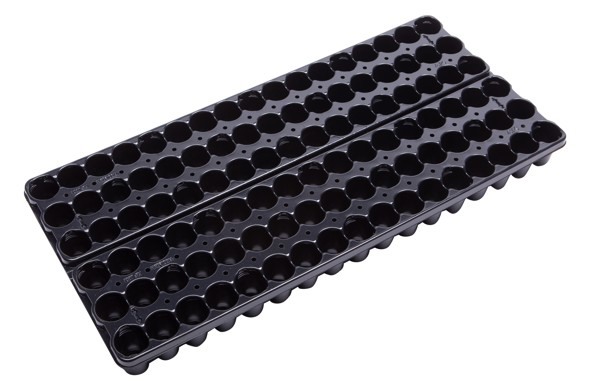
Modiform Tray
All components working together
Once Cole decided to switch from paperpots to Growcoons they made sure all components would work well together. Despite Growcoon being specifically designed to fit most propagation trays – there are 100+ sizes - Cole wanted a particular tray and asked Modiform to design one. "Since we buy many of our pots and trays from Modiform, it was only natural that we give them the specs for a tray that would make the most efficient use of our tables (benches) and also work well with the machine that fills the trays with Growcoons."
"Doug wanted a tray that is easy to separate into two equal parts, so a 102-cell tray will become two 51-cell trays. The advantage of this tray is that Cole can have more selections on one shipment", explains Kees van Beek, International Sales Manager at Modiform. So, the tray needed to be easy to separate, perfectly fit the Growcoon, and also need to be suitable for automation. The process of developing and producing this new tray took about three months. Now, Cole is using the tray, and this tray is now also included in Modiform's assortment.
The process
The end result is that the team at D.S. Cole uses the new Modiform tray to fill with just substrate, or they can drop in Growcoons and then fill with the same substrate. "The trays are dispensed automatically, then the Growcoons are inserted, and the trays go through a Javo Rotofill to be filled with substrate. After this, the tray continues on through a water tunnel and a dibbler." Then, the staff can stick the unrooted cuttings. "And since the substrate is not packed tightly, sticking goes faster." After the cuttings have been rooted, the plant, substrate, and Growcoon will be removed. "It can be removed easily, making the transplanting process quick and easy."
And storage of the raw materials is not an issue, adds Cole. "Boxes of Growcoons have a long shelf-life, yet once planted, they are fully bio-degradable."
For more information:
D.S. Cole Grower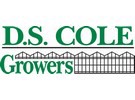 s
s
251 North Village Road
Loudon, NH 03307
Tel.: (603) 783-9561
Fax: (603) 783-9562
info@dscolegrowers.com
www.dscolegrowers.com
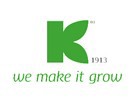
Klasmann-Deilmann
www.klasmann-deilmann.com
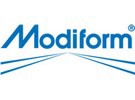 Modiform
Modiform
www.modiform.nl
